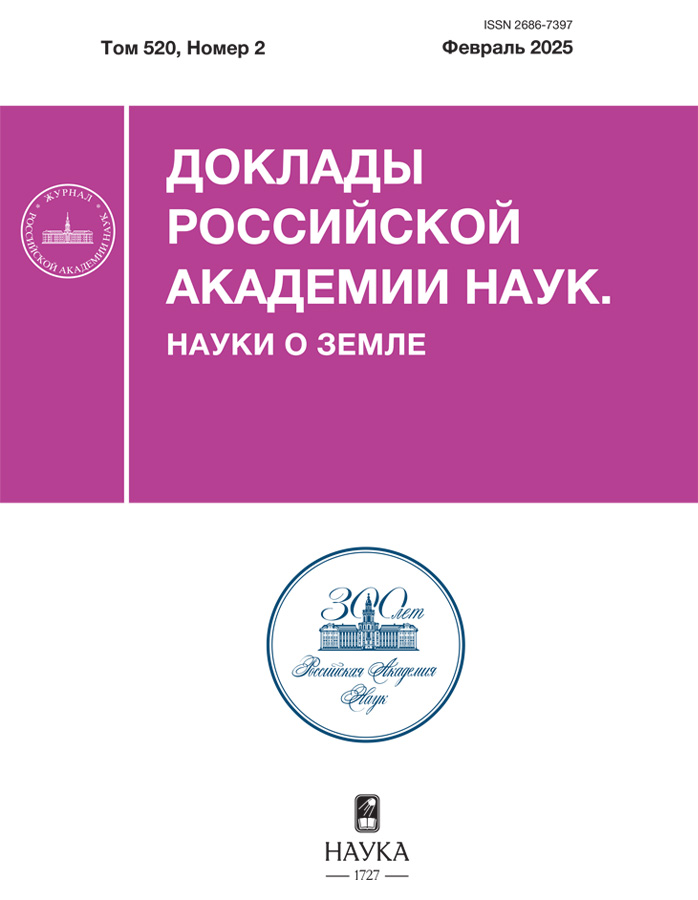Organic compounds in bottom sediments of the Kolyma mouth area
- Authors: Nemirovskaya I.A.1, Glyaznetsova Y.S.2, Gulev S.K.1
-
Affiliations:
- Shirshov Institute of Oceanology, Russian Academy of Sciences
- Federal Research Center “Yakutsk Science Center SB RAS,” Institute of Oil and Gas Problems, Siberian Branch, Russian Academy of Sciences
- Issue: Vol 520, No 2 (2025)
- Pages: 248-256
- Section: GEOCHEMISTRY
- Submitted: 18.06.2025
- Accepted: 18.06.2025
- Published: 04.09.2025
- URL: https://rjraap.com/2686-7397/article/view/685095
- DOI: https://doi.org/10.31857/S2686739725020083
- EDN: https://elibrary.ru/GDNXJI
- ID: 685095
Cite item
Abstract
The results of the study of chloroform bitumen (CB), organic carbon (Corg), aliphatic (ACHs) and polycyclic aromatic hydrocarbons (PAHs) in the bottom sediments of the Kolyma estuary showed that the sediments of the pier for small vessels in the village of Chersky, as well as in the port of Zeleny Mys, are the most polluted with oil products (according to IR spectra, composition of alkanes and PAHs). In 2018, the concentrations varied in the range: AHCs – 35–318 μg/g, PAH – 37–970 ng/g, weathered petroleum hydrocarbons dominated in the alkanes. In the sediments of the river itself and the Ambarchik Bay of the East Siberian Sea, the hydrocarbon concentrations were significantly lower: AHCs 71–25 μg/g, and PAHs – 28–100 ng/g), and terrigenous compounds of natural origin prevailed in their composition, and the Kolyma marginal filter copes with incoming pollutants. In subsequent years, the concentrations of hydrocarbons in port waters changed depending on the emissions of petroleum products.
Full Text
About the authors
I. A. Nemirovskaya
Shirshov Institute of Oceanology, Russian Academy of Sciences
Author for correspondence.
Email: nemir@ocean.ru
Russian Federation, Moscow
Y. S. Glyaznetsova
Federal Research Center “Yakutsk Science Center SB RAS,” Institute of Oil and Gas Problems, Siberian Branch, Russian Academy of Sciences
Email: glyaz1408@mail.ru
Russian Federation, Yakutsk
S. K. Gulev
Shirshov Institute of Oceanology, Russian Academy of Sciences
Email: gul@sail.msk.ru
Corresponding Member of the RAS
Russian Federation, MoscowReferences
- Gordeev V.V., Pokrovsky O.S. Zhulidov A.V. et al. Dissolved major and trace elements in the largest Eurasian Arctic rivers: Ob’, Yenisey, Lena and Kolyma // Water. 2024. V. 16. № 2. P. 316.
- Suzuki K., Park H., Makarieva O., Kanamori H. et al. Effect of permafrost thawing on discharge of the Kolyma river, Northeastern Siberia // Remote Sens. 2021. № 13(21). P. 4389.
- Никаноров А.М., Брызгало В.А., Косменко Л.С., Решетняк О.С. Устьевая область р. Колыма в современных условиях антропогенного воздействия // Метрология и гидрология. 2011. № 8. С. 74–88.
- Государственный доклад о состоянии и охране окружающей среды Республики Саха (Якутия) за 2022 г. [Электронный ресурс]. URL: https://yakutsk.bezformata.com/listnews/sredi-respubliki-saha-yakutiya/119798238/ (дата обращения: 28.07.2024).
- Glyaznetsova Yu.S., Zueva I.N., Chalaya O.N., Lifshits S.Kh. Features of Bitumoids Composition of Bottom sediments of the Coastal Zone of the East Siberian Sea // IOP Conf. Series: Earth and Environmental Science. 2018. V. 193. P. 012009.
- Lifshits S., Glyaznetsova Yu., Erofeevskaya L., Chalaya O., Zueva I. Effect of oil pollution on the ecological condition of soils and bottom sediments of the Arctic region (Yakutia) // Environ. Poll. 2021. V. 288. P. 117680.
- AMAP (Arctic Monitoring and Assessment Programme): Chemicals of Emerging Arctic Concern, Oslo, Norway, 2017. 87 p.
- Nemirovskaya I.A., Glyaznetsova Yu.S. The content and composition of organic compounds in the bottom sediments of the Norilsk-Pyasina water system one year after the accidental spill of diesel fuel // Marine Pollution Bulletin. 2024. V. 199. P. 115990.
- Yunker M.B., Macdonald R.W., Ross P.S. et al. Alkane and PAH provenance and potential bioavailability in coastal marine sediments subject to a gradient of anthropogenic sources in British Columbia, Canada // Org. Geochem. 2015. № 89–90. P. 80–116.
- Глязнецова Ю.С., Зуева И.Н., Чалая О.Н., Лифшиц С.Х. Нефтезагрязнение почвогрунтов и донных отложений на территории Якутии (состав, распространение, трансформация). Якутск: Асхаан, 2010. 160 с.
- Беллами Л. Новые данные по ИК-спектрам сложных молекул. М.: Мир, 1971. 318 с.
- Monitoring of Hazardous Substances in the White Sea and Pechora Sea: Harmonisation with OSPAR’s Coordinated Environmental Monitoring Programme (CEMP), Tromsø: Akvaplan-niva, 2011. 71 p.
- Немировская И.А. Нефть в океане (загрязнение и природные потоки). М.: Научн. мир, 2013. 432 с.
- Гавшин В.М., Лапухов С.В., Сараев С.В. Геохимия литогенеза в условиях сероводородного загрязнения (Черное море). М: Наука, 1988. 194 с.
- Немировская И.А. Распределение и происхождение углеводородов на трансарктическом разрезе через моря Сибири // Океанология. 2021. Т. 61. № 2. С. 209–219.
- AMAP (Arctic Monitoring and Assessment Programme), Ch. 4, Sources, Inputs and Concentrations of Petroleum Hydrocarbons, Polycyclic Aromatic Hydrocarbons, and other Contaminants Related to Oil and Gas Activities in the Arctic, Oslo: AMAP, 2007
- Corner E.D. Pollution studies with marine plankton. Part 1. // Advances in marine biology. 1978. V. 15. P. 289–380.
- Романкевич Е.А., Ветров А.А. Углерод в Мировом океане. М.: ГЕОС, 2021. 352 с.
- Лисицын А.П. Современные представления об осадкообразовании в океанах и морях. Океан как природный самописец взаимодействия геосфер земли. Мировой океан Т. 2. М.: Науч. мир, 2014. С. 331–571.
- Флинт М.В. Состояние проблемы в обосновании необходимости комплексных исследований экосистем морей Сибирской Арктики // Экоситемы морей Сибирской Арктики. М.: АПР, 2021. С. 3‒125.
Supplementary files














